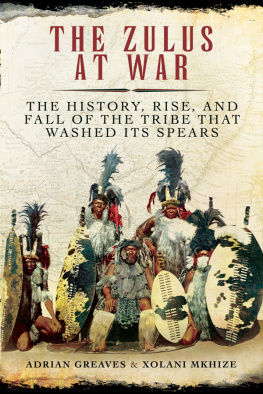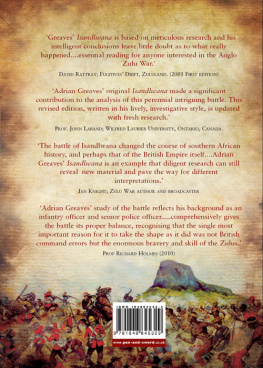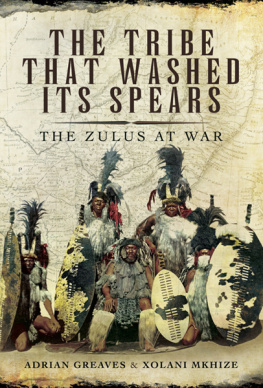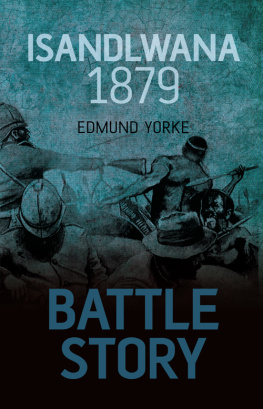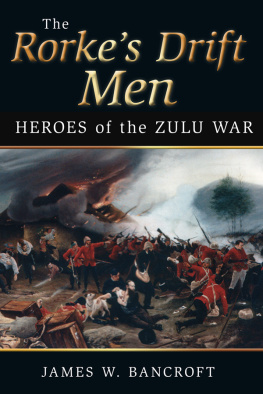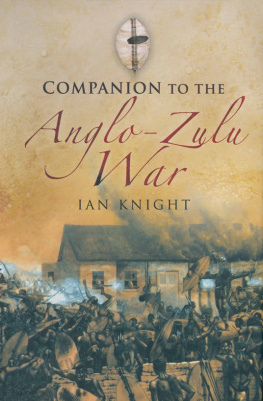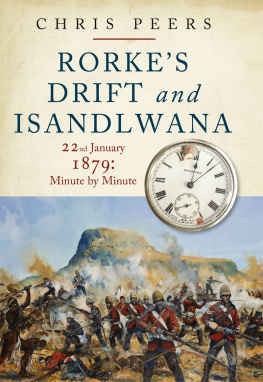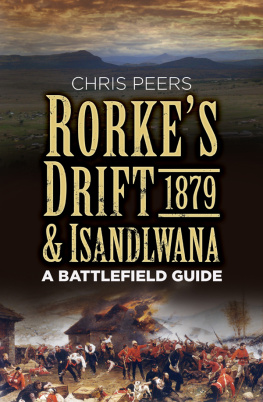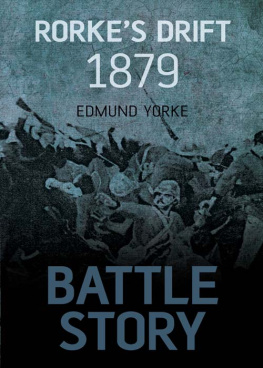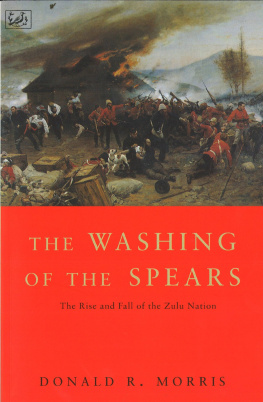The Defence of Rorkes Drift
Yes, for old Englands honour
And for her periled might,
We strove with vast and whelming odds,
From eve till morning light;
And thus with front unflinching,
One hundred strong we stood,
And held the post gainst maddened host,
Drunken with British blood.
BERTRAM MITFORD, 1879
RORKES DRIFT
ADRIAN GREAVES
CASSELL
In Memory of Norman Holme
Whose original research fired my own interest
Contents
List of Illustrations and Maps
PICTURE SECTION
MAPS AND PLANS
Acknowledgements
An account of The Defence of Rorkes Drift, signed by Major J.R.M. Chard VC, RE, at the personal request of Queen Victoria and first published in The Silver Wreath , copyright reserved. By gracious permission of Her Majesty Queen Elizabeth II.
I also gratefully acknowledge the kind and generous permission of the following people without whose co-operation and assistance this work would have been incomplete: Freda Holme who kindly allowed me to reproduce the nominal rolls and associated material from The Silver Wreath ; Dr Lita Webley of the Albany Museum, Grahamstown, South Africa, for kind permission to reproduce parts of her archaeological report concerning Rorkes Drift; Jack Karran and Tony Lucking for the Curling letters; Nicky von der Heyde for the drawings of Rorkes Drift, and Brian Best for his generous assistance relating to the Victorian period and medals.
For the use of photographs, I gratefully acknowledge Major Martin Everett of the 24th Regimental Museum; Ian Knight; the Curator of the British Empire and Commonwealth Museum; Ron Sheeley; Brian Best; the Anglo Zulu War Historical Society and the Killie Campbell Library in Durban.
For general guidance and advice, I gratefully acknowledge Ian Knight. I also owe much to David and Nicky Rattray and to David and Sue Charles at Fugitives Drift for their assistance and wonderful hospitality. I especially acknowledge Consultant Surgeon Clifford Stossel and his wife Katie who have supported me with their professional skill and human kindness during a long and painfull period of my life.
Needless to say, no one else had any direct control or influence over the final draft. I alone accept responsibility for any factual errors or omissions. I know others more expert and learned in the field will regard some of my conclusions as errors of interpretation but it is the uncertainty of knowing exactly what happened at Rorkes Drift that enhaces the excitment of the event.
Finally, I acknowledge the sacrifice of precious family time due to my reclusive study in preparation for this book. My wife, Debbie, and our three sons have all been especially patient and stoically accepted my need for frequent visits to Rorkes Drift for yet more research.
Chronology
11 December 1878 British ultimatum to Zulu King Cetshwayo.
11 December onwards British assemble along Zulu border in preparation for invasion.
11 January 1879 British invade Zululand leaving small garrison and hospital at Rorkes Drift.
20/21 January British establish camp at Isandlwana.
22 January Zulu army defeats British at Isandlwana; Zulu reserves attack Rorkes Drift.
Rorkes Drift battle timetable
8 a.m . Lt Chard RE rides the 10 miles to Isandlwana to check his orders. On hearing of the reports of approaching Zulus from mounted sentries and seeing that a party of Zulus was moving across the Nqutu Plateau towards Rorkes Drift, Chard starts back, arriving at the Drift at noon. Chard holds a brief discussion with Maj. Spalding but no action is taken.
2 p.m . Maj. Spalding, the officer commanding Rorkes Drift, leaves for Helpmekaar to speed the relieving companies to the mission station. Lt Chard given command at the mission station but stays at the river crossing. Distant rifle fire is then heard and men are seen crossing the Buffalo river.
2.30 p.m . At the river crossing, Lts Vane and Adendorff report the defeat at Isandlwana to Lt Chard. They carry Chards orders to Lt Bromhead at the mission station, and then ride off to Helpmekaar.
3 p.m . Lt Chard assumes command of the mission station while Mr Dalton organizes the construction of defence walls of bags of mealies and boxes of biscuits strengthened with two wagons built into the south wall.
3.30 p.m . Chard returns to the Drift to urge his men to retire with the water cart and tools. Lt Henderson with a large party of Durnfords Horse appears and is ordered to guard the ferry.
4.30 p.m . Chard returns to the mission station and orders six men to guard the hospital, reserve ammunition is made ready and bayonets are fixed. A lookout is posted on the ridgepole of the store.
5 p.m . On the approach of the Zulus, Lt Henderson and the native horse depart whereupon Capt. Stevenson and his native contingent also desert. The effective strength is now reduced from 350 to about 139 (including 30 sick). Men now taken from the line to construct a wall between the perimeter and the corner of the store (this became the famous wall of biscuit boxes providing the second and final line of defence).
5.30 p.m . The Zulus appear on the terraces of the Oskarsberg. The initial attack on the south of the defences is contained and the leading ranks of Zulus are pinned down by rifle fire. The main attack is diverted to the west of the hospital and along the thinly held northern wall. Zulu sniping from the Oskarsberg begins.
6 p.m . In desperate hand-to-hand fighting the defenders are forced to retire into the yard the hospital becomes vulnerable.
Hospital 6.20 p.m. to 7.15 p.m . Pte Cole (suffering from claustrophobia), Gnr Howard and Ptes Beckett and Waters flee the hospital; Cole, Adams (who had remained inside the hospital) and Beckett are killed, Howard and Waters survive the night in bushes. John Williams cuts a hole through the wall whilst Joseph Williams and Horrigan hold the Zulus at bay. John Williams pulls two patients through the hole before the Zulus burst in; they kill the four men in the room. The two Joneses help four patients to escape through the window in the corner room. The sick are assisted to safety by Pte Hitch and Cpl Allen (both already wounded).
6.45 p.m. Thatch fired.
7 p.m .until midnight The Zulus continue to attack in intermittent waves.
4 a.m . The Zulus retire.
8 a.m . Mission station is relieved by Lord Chelmsford and remnants of his Centre Column.
PART ONE
Introduction
It is more than probable that active steps will have to be taken to check the arrogance of Cetywayo, Chief of the Zulus.
LORD CHELMSFORD. COMMANDER-IN-CHIEF, SOUTH AFRICA.
Since prehistoric times the area of land around Rorkes Drift has been of considerable importance to mankind, primarily because it is one of the few crossing points of the Buffalo River, which in 1879 formed the 200 mile border between Zululand and British controlled Natal. Immediately down stream of Rorkes Drift the Buffalo river becomes impassable where it enters a precipitous gorge that speeds it into a fast-flowing torrent until its confluence with the predominant Tugela river. From this gorge onwards the Tugela surges through a steep-sided valley that hems it in until it reaches the sea. This physical barrier ensured that there were only two points of access into Zululand, either at Rorkes Drift some 60 miles from the sea, or at the coast where the Tugela river meets the Indian Ocean. At Rorkes Drift a rocky outcrop in the riverbed provided a reasonably safe and level crossing point for wagons, as well as a series of small islands that can, even today, be traversed by people jumping from rock to rock at low water. When the river was in flood, Rorkes Drift was the one place where a small boat could still be rowed across. This natural crossing point, or drift, and the comparatively level nature of the country on both sides have jointly contributed to the settlement of the area since prehistoric times. On the dominating rocky hillock that overlooks the river, rock paintings, stone artefacts and the remains of ancient human dwellings evidence a long history of human occupation.
Next page

